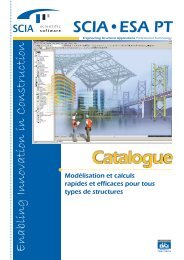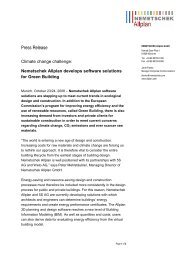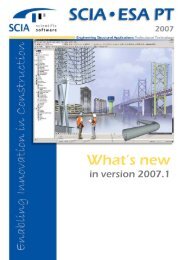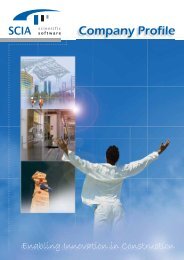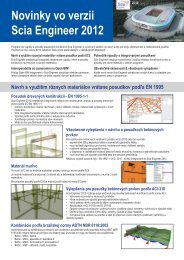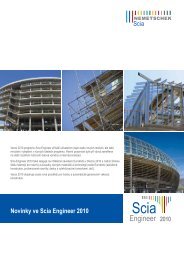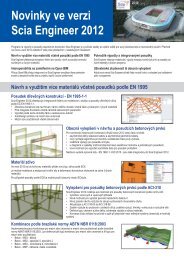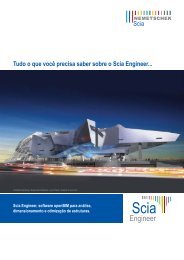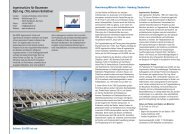VSH Turòa nad Bodvou - Nemetschek Scia
VSH Turòa nad Bodvou - Nemetschek Scia
VSH Turòa nad Bodvou - Nemetschek Scia
Create successful ePaper yourself
Turn your PDF publications into a flip-book with our unique Google optimized e-Paper software.
Introduction<br />
The CS underground station of the North/South Line is on Station<br />
Island. This station will be an integral part of the biggest public<br />
transport hub in the Netherlands and will provide transfer facilities<br />
between local, regional and international public transport systems.<br />
The underground stations’ concourse is being built under the main<br />
square in front of Amsterdam CS. There are entrances on ground<br />
level on both sides of the main entrance of the railway station and<br />
one at the south side of the station (in the direction of the city<br />
centre) leading to the main underground concourse. A direct link<br />
is being constructed from the platform level of the North/South<br />
Line to the central underground concourse and the platforms of<br />
the East Line.<br />
Ground conditions<br />
The soil profile at the site is different from the characteristic<br />
Amsterdam soil profile. Station Island is an artificial island that was<br />
built at the end of the nineteenth century for the construction of<br />
Amsterdam CS railway station for Dutch Railways. The island was<br />
created by filing in a channel area in the River IJ with sand. At the<br />
Station Island location the first Amsterdam underground sand layer<br />
is completely missing and the second sand layer is only partially<br />
present. The subsoil can be classified as poor.<br />
Boundary conditions<br />
The design of the underground station at Amsterdam’s Central<br />
Station (CS) was largely determined by local environmental<br />
constraints. The underground station is being built in front of,<br />
behind and also underneath the historic central railway station.<br />
Damage to the listed station building and delays to the different<br />
passengers and existing traffic flows are not acceptable. A further<br />
complication in the design was the soft and highly variable subsoil.<br />
Building an underground railway station on such a location can<br />
be considered as one of the most challenging constructions of the<br />
North-South line.<br />
Choice of software<br />
For the many unique, project-specific questions there are no existing<br />
regulations. This requires a multi-purpose software solution.<br />
Due to the high developed graphical output and the many modules<br />
we were able to solve a large scale of technical and geotechnical<br />
problems by using ESA-Prima Win in combination with M-Sheet<br />
and M-Foundation.<br />
Short description of the technical challenges<br />
Many phases during the building process are characteristic for<br />
this project. These phases have a major influence on the applied<br />
building method.<br />
Noord/Zuidlijn, station Voorplein, part of Central Station Amterdam<br />
A distinction can be made between the following parts with their<br />
own building phase:<br />
• The deep part with diaphragm walls, bored piles and jet grout<br />
struts. The deck of the roof will be build in parts and will be<br />
in use when the pit is excavated. The deep part will lead the<br />
passengers to the North/South Line platform with a connection<br />
to the immersed tunnel under the Central Station;<br />
• The middle deep part with diaphragm walls, driven piles and<br />
underwater concrete. The middle deep part connects the North-<br />
South line with the existing East Line;<br />
• The entrances from the central underground concourse to<br />
ground level.<br />
The following parts are specially mentioned<br />
Diaphragm walls<br />
The permanent diaphragm walls are calculated with MSheet.<br />
Because of unequal excavations the reaction forces will be redistributed.<br />
This redistribution is determined with ESA-Prima Win and<br />
after this corrected in MSheet. After excavation a secondary cast<br />
inner wall will be made. This compound wall has a complex geometry<br />
and is calculated with 3D-Shell.<br />
Jet Grout Strut<br />
Stresses in the diaphragm walls will be reduced by applying a horizontal<br />
jet grout strut which is placed before excavation. During<br />
excavation normal forces and curvature due to swelling groundlayers<br />
will occur. This complex situation is investigated with a 3D<br />
Shell model including non-linear spring supports.<br />
Bored piles / steel concrete columns<br />
Before excavation the roof structure is made. This structure will be<br />
supported by 20 m long steel concrete columns placed in 40 m<br />
long bored piles with a diameter of 1200 mm.<br />
The bearing capacity is determined by MFoundation. The structural<br />
behavior is determined by ESA-Prima Win and includes non-linear<br />
soil behavior and second order effect.<br />
Other structural parts<br />
The walls, floors are all calculated with ESA-Prima Win using<br />
different kind of modules.<br />
Points for emphasis<br />
It is important to keep complex 3D-models simple and more<br />
controllable. Clear agreements have been made concerning the<br />
influence of several construction components. Where necessary,<br />
calculations have been completed with the geotechnical programs<br />
of the MSerie.<br />
This ensures an optimum interaction of the possibilities of constructive<br />
and geotechnical software.<br />
Used modules<br />
• MSheet, MFoundation<br />
• 3D Shell<br />
• 2D Plate and 2D Wall<br />
• 2D and 3D Frame<br />
• Physical non-linear conditions<br />
• Second order and stability frame<br />
• Construction stages<br />
91




